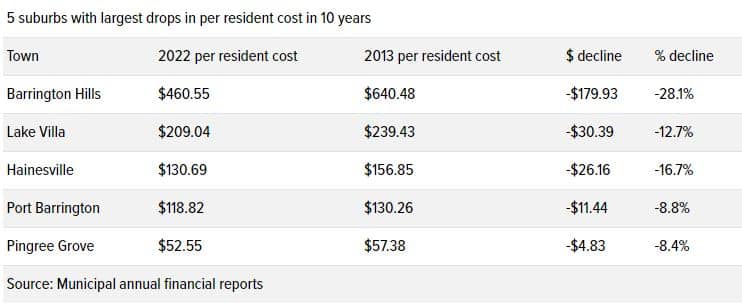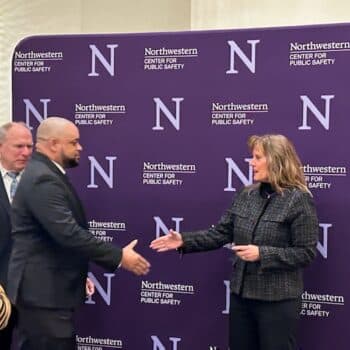
How much property taxes per person does it cost to run your town?
- Posted by Barrington Hills
- On January 29, 2024
Daily Herald | January 28, 2024
Jake Griffin
Property taxes used to fund daily operations of suburban municipalities have climbed an average of $44 per resident from 10 years ago.
In at least nine suburbs, the amount of property taxes charged per resident has climbed more than $100 from a decade ago.
That’s according to a Daily Herald analysis of annual financial reports municipalities submit to the Illinois Comptroller’s office that show how much property tax revenue is earmarked for each town’s general fund. General funds cover the vast majority of day-to-day operational costs of municipalities. Municipal general fund property taxes per resident
| 5 suburbs with highest per resident cost growth in 10 years | ||||
| Town | 2022 per resident cost | 2013 per resident cost | $ growth | % growth |
| West Dundee | $740.61 | $444.67 | $295.94 | 66.6% |
| Hoffman Estates | $458.46 | $317.53 | $140.94 | 44.4% |
| Wheeling | $399.44 | $266.70 | $132.74 | 49.8% |
| Aurora | $443.02 | $311.90 | $131.12 | 42.0% |
| Downers Grove | $344.08 | $217.64 | $126.44 | 58.1% |
| 5 suburbs with largest drops in per resident cost in 10 years | ||||
| Town | 2022 per resident cost | 2013 per resident cost | $ decline | % decline |
| Barrington Hills | $460.55 | $640.48 | -$179.93 | -28.1% |
| Lake Villa | $209.04 | $239.43 | -$30.39 | -12.7% |
| Hainesville | $130.69 | $156.85 | -$26.16 | -16.7% |
| Port Barrington | $118.82 | $130.26 | -$11.44 | -8.8% |
| Pingree Grove | $52.55 | $57.38 | -$4.83 | -8.4% |
| Source: Municipal annual financial reports | ||||
“I would expect more and more of this because of pension obligations,” said Sheila Weinberg, founder and CEO of Truth in Accounting, a group advocating for more uniform, understandable and accessible government financial reporting requirements. “Municipalities are relying more and more on property taxes to cover losses elsewhere.”
Among 84 suburbs in Cook, DuPage, Kane, Lake and McHenry counties that levy property taxes to cover operational costs, West Dundee charges the most at nearly $741 per resident, according to the analysis. That’s almost $296 more per resident from a decade ago.
West Dundee Village Manager Joseph Cavallaro defended the village’s property tax collections.
“You’ve got to compare apples to apples here,” he said. “We’ve got a fire department where a lot of other towns have an independent fire protection district, so add those two funds together to get an idea of what those residents are being charged for similar services.”
Cavallaro said that while a municipal fire department increases the village’s need for more property tax revenue, it saves taxpayers through administrative consolidation.
Additionally, he noted more than $1 million of the general fund’s property tax collections are transferred into the village’s capital improvement fund annually and not used on day-to-day operation costs.
But Cavallaro also acknowledged the village has become more reliant on property taxes in recent years as sales tax revenues from Spring Hill Mall have shrunk.
“Unfortunately the property tax levy has increased to make up that difference,” he said.
The village also funds public safety pensions toward a goal of being 100% funded, not 90% as required by the state, Cavallaro added.
But Weinberg notes the village still has a long way to go to reach that pension funding goal.
“Just the police alone, they’d have to lay off the entire department for six years and put all those salaries toward the pension fund to catch up,” she said.
Similar to West Dundee, suburbs including Hoffman Estates, Wheeling, Aurora, Downers Grove, Elk Grove Village and Sleepy Hollow also saw the property tax rate per resident increase by more than $100 from 10 years ago. And they also have their own fire departments that increase demand for property taxes, not only to cover payroll costs, but pension funding requirements as well.
“Our corporate levy has not increased over the years, it’s the pension funds that are the reason for the increase,” said Rachel Musiala, Hoffman Estates’ finance director. “That’s what you’re seeing.”
She noted that annual pension payments for both public safety pension systems are more than double what they were 10 years ago.
Inflation has driven the need for additional property tax revenue as well, suburban leaders lament.
“It’s not just personnel costs, but commodities have seen a dramatic increase, and so our operating costs followed suit on that same percentage,” Cavallaro said.
Inflation has risen 27% during the last 10 municipal fiscal years, according to the U.S. Bureau of Labor Statistics. The most recent municipal fiscal year ended April 30, 2023.
According to the analysis, 27 of the 84 suburbs saw the per-resident property tax cost rise by more than 27% during that time. While the growth is sometimes fueled by voter-approved tax increases, that’s certainly not the case for most towns.
And there are also suburbs where the cost per resident has actually declined from 10 years ago. Property taxpayers in Hainesville, Lake in the Hills, Lake Villa, Oakbrook Terrace, Pingree Grove and Port Barrington all saw modest declines.
But the property tax cost per resident in the Barrington Hills general fund dropped the most during that time with taxpayers there paying nearly $180 per resident less than 10 years ago.
“We’re very proud of that,” said Anna Paul, the village’s director of administration. “For the last decade, basically the board has deliberately tried to run the village as efficiently as possible, while still running services at the high level residents expect.”
Paul pointed to cost-cutting measures such as using technology upgrades to reduce personnel headcount, contracting work instead of hiring and reducing some posts to part-time positions.
“It’s been the board and staff really looking at our budget and being very aggressive in terms of what we really need to spend,” she said.
Link: How much property taxes per person does it cost to run your town?


